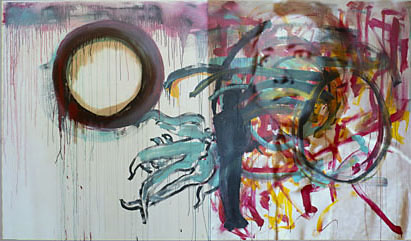 |
.jpg) |
In contrast, the artist’s large-format color photos, which line three walls of the same gallery, represent vestiges of the Old Sublime, what the eco-activist writer Edward Abbey termed “industrial tourism”. They show camera-toting tourists in national parks, snapping pictures of each other before scenes that in the 19th century would have been fodder for Romantic painters. Preternaturally lit as if composed in a studio, they function as brilliant send-ups of a certain genre of gift shop postcards, but they don’t tell us much about the commodification of nature that we don’t already know. Hall’s video, which floats above the taint of knowing irony, is clearly the main event.
 |
Andy Grunberg, the former Times photography critic curated this exhibit. Wisely, he opens it with three of the most powerful images of Spiral Jetty you're likely to see. Dusted in salt and with the Jetty looking uncharacteristically crisp, they look as much like paintings as they do photographs, proving that Leibovitz's exquisite touch with light isn't dependent on studio effects; it's a part of her being, something she carries with her. Her frothy picture of Niagara Falls; the orange-glowing images of Jefferson’s vegetable garden; the blinding window view from Virginia Woolf’s writing studio; and the otherworldly blue light suffusing Annie Oakley’s home turf are all wonderful examples.
 |
The painter Hung Liu, whose interests are time, memory and Chinese history, is seen here experimenting with video. The piece that registers strongest, Remnant, is a diptych, the last of “Four Cantos” that the artist created with fast strokes in a span of minutes by painting on top of projected films. Equal parts action painting, performance and installation, it is, almost by definition, a work that is in the process of becoming. It asks viewers to complete it, and we do. By straining to decipher a plot or narrative in the silent Chinese propaganda films that flicker on top of the artist’s gestures, we follow the same path as Liu does when she paints from old photographs: We project ourselves into a world that no longer exists, and then attempt to extract meaning from it. It’s a conceptual/perceptual territory rich in possibilities that I hope she’ll explore further.